Žurnalistikos tyrimai ISSN 2029-1132 eISSN 2424-6042
2019, 13, pp. 46–76 DOI: https://doi.org/10.15388/ZT/JR.2019.2
Al-Jazeera’s Talk Shows Treatment of the Saudi Journalist. Jamal Khashoggi’s Case
Rasha A. Salameh
Blanquerna-Universitat Ramon Llull
School of Communication and International Relations,
rsalameh1984@gmail.com
Abstract. This paper attempts to evaluate Al-Jazeera Arabic Channel talk shows’ treatment of the Saudi journalist Jamal Khashoggi’s case by posing two main questions: the first deals with the amount of coverage granted to this issue. One of the research hypotheses arises here, namely that the coverage was remarkably intense, which may be explained by Al-Jazeera’s dedicated position on the issue. This is explored in this paper through analysis of content and by interviewing the director of news at Al-Jazeera channel, Asif al-Humaidi, and by surveying previous studies that have linked Al-Jazeera’s previous positions to Qatar’s official stand, particularly that the Khashoggi incident took place in the midst of the Qatari-Saudi political crisis. The research samples include four talk shows: “Without Borders,” “Beyond the News,” “Rest of the Story” and “Scenarios,” over the course of a month since Khashoggi’s disappearance. The analysis shows that Khashoggi’s case received 93% of the total coverage of the four programs during the monitoring period.
The second question deals with several items in the professionalism category, in terms of balancing time granted to the guests, and the degree of objectivity shown by the presenters during the dialogue. It was found that the rate of the presenters’ interventions during guests’ presentation was 57%, in addition to temptations utilized during the dialogues. Another question arises regarding the extent of hate speech in these talk shows, which amounts to 69.4%, by analyzing several items, most notably emotional mobilization, which rated 40.7%.
Keywords: Al Jazeera, media, talk shows, balance, objectivity, Gulf crisis, hate speech.
Received: 20/12/2019. Accepted: 02/04/2020
Copyright © 2019 Rasha A. Salameh. Published by Vilnius University Press. This is an Open Access article distributed under the terms of the Creative Commons Attribution Licence (CC BY), which permits unrestricted use, distribution, and reproduction in any medium, provided the original author and source are credited.
1. Introduction
Throughout the twentieth century, the world witnessed structural changes that led to the collapse of many constants, and the launching of a series of changes and interactions that continue to expand and deepen to present many phenomena and issues on the dialogue table.
Mass communication has been able to be the arena in which this most effective event is practiced, especially in the programs of satellite channels, because of the popularity of these channels and the novelty of the issues presented, and the attractiveness of the dialogue in a manner and content (Ananza, 2017).
Specialized satellite news channels, through their news, opinions, programs and various content, especially talk shows, contribute to shaping and guiding the public opinion of the society, and working to identify the trends of individuals and to shape their perception of the various issues and current events, as a result of the different advantages, characteristics and influences it enjoys. (Al-Halahleh, 2012). Talk shows are one of the most popular programs and patterns on maps and program cycles in specialized satellite news channels. Individuals accept it as a public window dealing with various issues and events, supported by analysis, interpretation, explanation and presentation of different perspectives.
Adding to the importance of political talk shows in specialized satellite news channels, they include ideas, analysis and comments by specialists on these issues, which helps to open new horizons for the recipient, which can modify its trends or change. In addition, it makes viewers better able to observe reality, get acquainted with the current events, to form opinions about them, increase their ability to discuss public issues with other viewers, as well as acquire current political information in the local or global environment (Al-Yamahi, 2012).
A number of specialized satellite news channels have emerged on the Arab media scene, resulting in a variety of programs offered by these channels. Among these programs are political talk shows that play an important role in informing viewers on the most important current political issues, by hosting political or Informational figures (Al-Mutairi, 2016).
Al Jazeera is at the forefront of specialized satellite news channels that have an impact on the viewer, especially the Arab viewer. The channel broadcasts several news bulletins and talk shows. Al Jazeera has played an important role on many fronts, and has become described as an influential player in the global media scene and a strong competitor to win the audience with CNN and BBC (Janabi, 2016).
Based on the above, this research came to identify the extent of Al-Jazeera coverage of the issue of the killing of Saudi journalist Jamal Khashoggi; for the purposes of influencing public opinion, towards Saudi Arabia, especially as the event coincided with the siege imposed on Qatar by Saudi Arabia and other countries, in addition to the fact that the repetition of the message from During repeated exposure to media messages, this will have the desired effect.
2 Literature review
The literature review reviewed the theory that explain the study, which is the theory of media framing, as well as the concept of public opinion, the emergence and definition of Al-Jazeera, in addition to the most important previous studies related to the current study.
2.1 The media theory used
This research examines the degree to which Frame Analysis Theory apply to Al-Jazeera’s coverage, specifically its talk shows included in the sample, in the case of the Saudi journalist Jamal Khashoggi.
2.1.1 Media Framing Theory
Researchers and experts in media studies agree that the concept of framing derives its theoretical origins from those who support social and psychological studies. Scientists such as Bateson (1972) and Goffman (1974) see it as a focus on certain events, symbols and stereotypes that have entered the text, and psychologists see changes in judgments (Shanto, 1993).
The Frame Analysis Theory suggests that the event may not have a major significance to the recipient, but it happens to be addressed by the media within a particular media framework using language influences, drafting and highlighting a particular aspect, for that event to become central (Entman, 1993).
In explaining how the media can influence the minds of the masses through the framing mechanism, Entman et al, (2009) drew attention to that the framing theory speaks of the fact that the process is carried out through selectivity in inclusion, exclusion, partial inclusion, and neglect, in contrast to highlighting one particular aspect.
Among the media frameworks that apply to the above-mentioned case of Al-Jazeera is the case-specific framework, which addresses an issue by focusing on some of its aspects and neglecting others, and finally producing it in a certain way that suits the news medium.
Similarly, the human-interests framework places events in a human and emotional context, through which the media content is formulated in some influential dramatic and emotional formulations. According to this theory, the sender chooses frameworks for the recipient to perceive the event and the situation through (Robin, 2003). This theory speaks of the sender who is subject to his cognitive patterns and professional pressures, such as those relating to funding and ownership of the media institution, and of the selective cognition process, whether it is the result of consciousness or not.
De vreese (2005) believes that it is among the mechanisms which the news medium using framing depends on: the position occupied by the story and its specified space, the symbols, supporting materials, and graphics it includes, subjectification, dramatic emotional temptation attempts, selectivity, partial inclusion, demonization, as well as selective choice of sources, introductions and closures used in the media content, In addition to headings, subheadings and headers.
In his study, De vreese (2005) cites the views of researchers who argue that framing creates contexts, identifies the problem, diagnoses its causes, makes ethical judgments, and proposes solutions in addressing an issue.
Researcher Hassouna (2015) reviews a set of definitions presented by researchers, such as Mohamed Bassiouni, who says that this theory is the angle of media handling, in a context that is present in the mind of the contactor, as the producer of the speech frames it in accordance with his/her ideas and agendas, by focusing on certain aspects and neglecting others, within the media discourse, and highlighting elements and marginalizing others, to achieve certain ideological or intellectual objectives related to the contactor or the news medium through which the speech was produced.
2.2 Public Opinion
Ziolkowski (2001) defines public opinion as: “An organizational social force that denotes and follows people’s attitudes, and it is the interaction of personal opinions that are the basis for the formation of this opinion, for many people when this subject requires public attention towards a vital subject, including It is enough to urge people to take a stand. People care about it and express that interest through their personal opinions that shape public opinion”. According to Sultan (2004), the concept of public opinion is the orientation of society towards one of its issues in basic internal or external matters. Where the issue occupies the existence in his thought, and affects him negatively or positively, and makes him move towards facing this issue acceptance or rejection. Scheufele and Eveland (2014) also defined Public opinion as: “The prevailing opinion among the conscious majority of the population in a given period of one or more issues, in which controversy and debate rages, directly affects the interests or fundamental human values of this majority.
The media, especially the specialized satellite news channels, are of great importance in influencing the public’s attitudes and determining their attitudes towards the various issues that revolve around it, through its programs capable of influencing the formation of public opinion trends based on the political, cultural, religious and social offerings and products.
Since the media is - most of the time - subject to the policies of the countries and organizations affiliated to them, it tries hard to present events and news according to the point of view of those behind them, and thus raced countries and major thanks to the construction of large media networks to control people’s ideas, tendencies and orientations under the pretext of “disclosure Truth”, “Objectivity”, and “opinion freedom” (Kanaan, 2014).
2.3 previous studies
Upon examining previous studies, a gap was found that can be considered one of the difficulties of the study, namely, the novelty of the topic being discussed, i.e. the part on Khashoggi in particular, and the part on reforms in Saudi Arabia, particularly those related to the Saudi Crown Prince Mohammed bin Salman. Therefore, studies on this particular part were not available. So, research papers and books that talk about the importance of Al-Jazeera in the Arab media scene were used, in addition to the extent of its objectivity and professionalism, its relevance to the Qatari regime and the position of the Arab regimes on this issue. Furthermore, studies that talked about the recent political crisis among the Gulf States were also used.
Since its launch in 1996, Al-Jazeera Channel has received a remarkable research interest by many scholars. For example, there were 57 books, 74 studies, and 66 theses about it, between 1996 and 2011 (Al-Khazendar, 2013, Moula, 2017), and there are even those who date for the Arab media before and after Al-Jazeera, because it represents a different phenomenon in the Arab media scene which was dominated by the official channels for a long time (Al-Khazendar, 2013).
Al Jazeera has played an important role on many levels, and has become described as an influential player in the global media landscape and a strong competitor in gaining audiences against CNN and the BBC (Moula, 2017), especially when talking about its broadcasters as educated in Western universities and previous employees of the abovementioned international media organizations, in addition to being the first Arab station to host Israeli officials (Azran, et al, 2016). Perhaps it was the first time foreign stations broadcast through an Arab channel when Al-Jazeera was present during the Arab Spring and when the protestors were showing its bulletins on large screens in the public squares (Al-Khazendar, Ali, 2013).
Al Jazeera has actually played two roles: one internal and one external. The internal role focused on discussing what was considered controversial and taboo in the Arab world, in addition to talking about Arab regimes. The external role, on the other hand, took the form of presenting Arab and Islamic views on regional and international events. Al Jazeera was established in one of the most liberal media environments in the region, taking advantage of the decline of BBC Arabic and Voice of America (Seib, Powes, Gilboa, 2007).
At the same time, protests by Arab regimes against Al-Jazeera, which has long been linked to the official Qatari position, have escalated (Seib, Powes, Gilboa, 2007). Perhaps the story of funding this channel from the beginning (Moula, 2017) confirms this idea in one way or another to the advocates of this theory, in addition to the lack of the channel’s coverage of the Qatari affairs with the same critical enthusiasm as with other Arab regimes. This was justified by Al-Jazeera news director Asif Al- Humaidi (Al- Humaidi, 2019), when he said that the channel was not a Qatari TV channel. The channel had also previously given an excuse, namely that the geographically small Qatar does not play a global role that places it in the news headlines. This has been rebutted more than once when talking about its objectivity in dealing with the implications of Qatar’s FIFA World cup 2022 hosting, and turning a blind eye to violations of the safety of workers and how Western media covered it (Azran, et al, 2016).
The Saudi regime had criticized Al-Jazeera earlier, and religious fatwas were issued prohibiting Saudis from appearing on its screen. Further, Al-Jazeera broadcasters were banned from broadcasting from inside Saudi Arabia, and the Saudi regime also banned showing the channel in cafes, in an effort to limit the channel’s viewing. It’s worth mentioning that the Saudi and Kuwaiti regimes are the most prominent regimes who commercially contributed to boycotting Al-Jazeera in terms of advertising on its screen (Seib, Powes, Gilboa, 2007).
Al-Humaidi,(2019) during his interview had talked about this point, saying that Al-Jazeera correspondents were present in Mecca, Riyadh, Jeddah, and other places, and they were present on the border with Yemen, but they were banned after the siege. He asks, “after we were stopped and expelled, are we to be blamed for the coverage? When Saudi Arabia and the blockade countries put us at the crossfire and demanded our shutdown, should we not be keen on staying? Shouldn’t we defend the existence of Al-Jazeera and the truth it offers to millions with our blood, money and media platforms?” He continues to say that “the Saudi side, even the UAE, distance themselves, and I try to get closer by attempting to contact, hundreds of times, figures who can present the official view of Saudi Arabia and the UAE on our screen. It happens that we host those we know are coming to insult us, and yet we welcome them.”
Perhaps the issue under discussion, that of the Saudi journalist Jamal Khashoggi, which coincides with the siege imposed on Qatar since June 5, 2017 by Saudi Arabia, the UAE, Bahrain and Egypt in one of the biggest crises facing the GULF Cooperation Council since its founding and in a move similar to the declaration of war (Al-Ramadani, 2018), compels the researcher to link two things together: the intensity of coverage which the Khashoggi’s case received by Al Jazeera and the objectivity of the coverage, on one hand, and the state of
political tension witnessed by the relationship between Qatar and Saudi Arabia, on the other.
This is because Al-Jazeera is located in Qatar and the fact that the other party is Saudi Arabia, represented in this case by its regime, specifically the person of Saudi Crown Prince Mohammed bin Salman, who was more than once referred to in the talk shows, which will be analyzed, as a perpetrator in the disappearance and death of Khashoggi. In addition to all this, one of the demands of the blockade countries on Qatar is the shutdown of Al-Jazeera and its affiliate channels, which was one of thirteen demands (Azzam, 2017). Al-Humaidi commented on this during his interview (Al-Humaidi, 2019) saying this demand “drove Al-Jazeera to intensify its coverage, in order to convey the voice of truth, which others do not want it to do.”
3. Study problem
There are questions regarding Al-Jazeera’s objectivity, which is not new, but is linked from the outset to the extent of the channel’s independence, because of its funding by the Qatari regime. The question was strongly present during the Gulf crisis, particularly since the channel shutdown was among the demands made by Gulf regimes to lift the blockade on Qatar. The Khashoggi case came during the Gulf crisis, and with remarkable intensification, which raised the question about the coverage volume this case received, the objectivity of the channel in this coverage, and whether there is a balance in handling the issue, or hate speech with every element it may involve, such as emotional mobilization, incitement, insult, stigmatization, and so on.
4. Study hypothesis
The study assumes that there is a high intensification in the coverage of the Khashoggi case, for the purposes of influencing public opinion towards Saudi Arabia, particularly that the event coincided with the blockade imposed on Qatar by Saudi Arabia and other countries, in addition to the fact that repeated exposure to media messages would bring about the desired effect, whether it be spontaneous, or belated.
The study assumes that there is a flaw in the objectivity of the talk shows that dealt with the issue, given previous studies that had indicated a flaw in the objectivity of Al-Jazeera, when it comes to an issue against which the Qatari regime has a position. In the Khashoggi case, the party at which fingers were pointed was Saudi Crown Prince Mohammed bin Salman, who played a prominent role in imposing the blockade on Qatar, in addition to the fact that Al-Jazeera shutdown was demanded for the blockade to be lifted, apart from earlier official Saudi positions on Al-Jazeera. All of this has contributed to the creation of this hypothesis, which will be tested during the research.
5. Study questions
• How much coverage, of the total coverage, did the Khashoggi case receive in these talk shows?
• What kind of dialogue was going on in these episodes? Was it an information dialogue concerned with collecting information about a certain issue, an opinion dialogue intended to survey opinions regarding the issue raised, a character dialogue that focused on a particular person’s views and positions, or any other pattern?
• What form did the dialogue take: was it a dialogue with one or more than one guest? Was it face-to-face, via satellite or over the phone?
• What were the career titles of hosted guests, and did a particular name influenced the objectivity and professionalism in handling the case?
• What methods did the presenter use in the dialogue, were they propaganda, discussion, analytical or other?
• What is the nature of the supporting materials attached to the dialogue?
• Did the presenter give his guests enough time to talk? Was there a balance in the time granted to each party?
• Was the presenter objective, or did they try to impose themselves and their visions during the guests’ participation?
• Was the direction of dialogue professionally, positive or negative?
• Were there any temptations employed during the dialogue? And what kind of temptations?
• Was there hate speech in these episodes? If the answer is yes: What elements of the hate speech that have been spotted?
6. Methodology and data collection
6.1 Methodology
This study relied on the content analysis methodology, which mainly depends on converting the written information into numbers describing the phenomenon being studied. Suliman (2009) defines the method of content analysis as: “an objective method of quantitative and qualitative judgment at the same time, and contributes to taking the appropriate decision, as it helps in achieving the goals of scientific research that is concerned with studying in this field. In particular, research related to analyzing media or journalist content”. Neuendorf (2002) believes that content analysis is: “a quantitative summary analysis of the content, which is based on the scientific method, including objectivity, internal subjectivity, initial design, reliability, truthfulness, generalizability, reproducibility, and hypothesis testing, and is not limited to the types of variables that can be measured, nor on the context in which the content is displayed”
There are many studies that have used the content analysis methodology, among these studies is the study (Al-Sakji, 2018) that aimed to analyze the content of scientific programs in Arab satellite channels and investigate their effects as an informal format in learning, and a study (Al-Mansour, 2015) that aimed to analyze the content of Arab newspapers in its handling of Trump’s decision to consider Jerusalem as the capital of Israel.
This study used the content analysis methodology through analyze four talk shows aired on Al Jazeera Arabic: the daily talk show “Beyond the News,” and three weekly talk shows: “Without Borders,” “Scenarios” and “Rest of the Story”.
6.2 Monitoring sample
This research deals with four talk shows aired on Al Jazeera Arabic: the daily talk show “Beyond the News,” and three weekly talk shows: “Without Borders,” “Scenarios” and “Rest of the Story.” The monitoring period continued for a month, from the day Khashoggi disappeared on October 2, 2018 until November 2, 2018.
6.3 Data collection technique
The research was based on several ways for data collection:
1. Monitoring and analysis of the content of the four dialogue talk shows during the above-mentioned monitoring period, through a monitoring scout who has been arbitrated by a number of professors specializing in the media.
2. Interview with Al Jazeera News Director in Qatar Asif al-Humaidi.
3. Reference to previous studies on Al Jazeera and the Gulf crisis.
7. Data Analysis
• Results of the first question: How much coverage, of the total coverage, did the Khashoggi case receive in these Al-Jazeera talk shows?
• Talk shows dealing with the Khashoggi case
Table 1: Talk shows that dealt with the Khashoggi case on Al Jazeera
|
Talk Show |
Repetition |
Percentage |
|
Without Borders |
19 |
8.8% |
|
Beyond the News |
135 |
61.6% |
|
Rest of the story |
21 |
9.6% |
|
Scenarios |
41 |
18.7% |
|
Total |
216 |
100% |
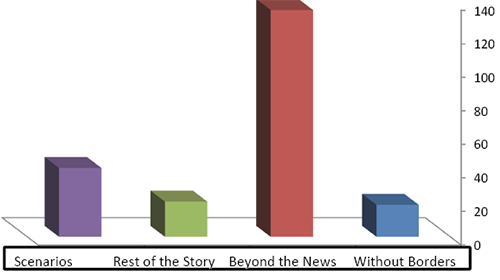
Figure 1: Talk shows that dealt with the Khashoggi case on Al Jazeera
It is noted from table (1) data that the program “Beyond the News” is the most talk show covering the Khashoggi case by (61.6%) among the study sample shows, followed by “Scenarios” by (18.%) , “ Rest of Story” by 9.6%, and in the last place comes “Without Borders,” with a percentage of (8.8%).
• Coverage volume
Table 2: Talk shows coverage of Khashoggi’s case on Al Jazeera
|
Coverage |
Iteration |
Percentage |
|
There‘s coverage. |
200 |
8.8% |
|
There‘s no coverage. |
216 |
61.6% |
|
Total |
216 |
100% |
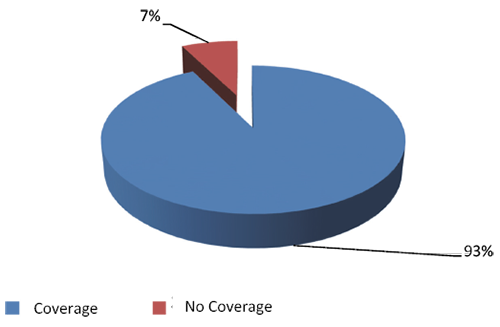
Figure 2: Talk shows coverage of Khashoggi’s case on Al Jazeera
Data in Table (2) shows that 93% of the sample talk shows covered the Jamal Khashoggi’s case, while 7% did not.
Based on tables (1) and (2), it can be said that the coverage volume of Jamal Khashoggi’s case in these talk shows was very high at 93% of the total talk shows, and that the most talk show that covered the Khashoggi case was “Beyond the News.”
Results of the second question: What kind of dialogue was taking place in the episodes of the talk shows that dealt with the Khashoggi case on Al-Jazeera?
Table 3: Types of dialogue in the talk shows that dealt with the Khashoggi case on Al-Jazeera
|
Dialogue |
Iteration |
Percentage |
|
Information Dialogue |
4 |
1.9% |
|
Opinion Dialogue |
162 |
77.1% |
|
Guest dialogue |
00 |
00 |
|
Mixed |
00 |
00 |
|
Other |
44 |
21.0% |
|
Total |
210 |
100% |
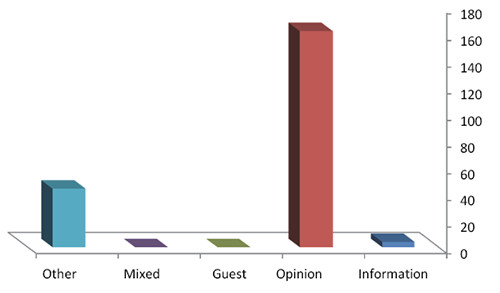
Figure 3: Types of dialogue in talk shows
Table (3) shows that most of the dialogues that took place in the talk shows covering the Khashoggi case on Al-Jazeera were opinion dialogues, a type of dialogue that aims at knowing the opinion of the interlocutor on a certain topic. This type of dialogue comprised a percentage of (77.1%), followed by other dialogues that were not mentioned in the categories of analysis. In the last place comes the information dialogue that aims at collecting information on a certain topic, at only 1.9%. There are two types of dialogue that were not used in the sample talk shows: guest dialogue and mixed dialogue.
Results of question 3: What form did the dialogue take in the talk shows covering the Khashoggi case on Al-Jazeera
Table 4: The form of dialogue in the talk shows that dealt with the Khashoggi case on Al Jazeera
|
Dialogue Form |
Iteration |
Percentage |
|
|
One guest Dialogue |
Face-to-face dialogue |
30 |
48.4% |
|
Phone dialogue |
00 |
00 |
|
|
Satellite dialogue |
32 |
51.6% |
|
|
Total |
62 |
29.5% |
|
|
Dialogue Form |
Iteration |
Percentage |
|
|
Multi-guest Dialogue |
Face-to-face dialogue |
00 |
00 |
|
Phone dialogue |
00 |
00 |
|
|
Satellite dialogue |
105 |
100% |
|
|
Total |
105 |
50.0% |
|
|
Other |
|
43 |
20.5% |
|
Total |
210 |
100% |
|
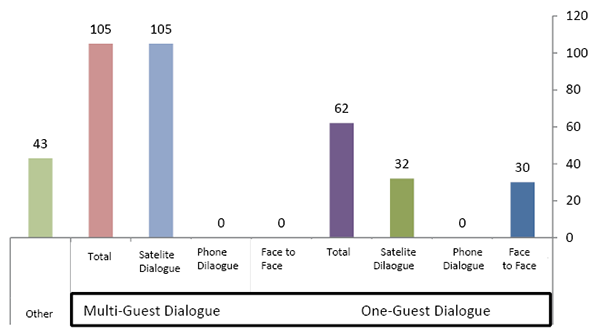
Figure 4: The form of dialogue in the talk shows
Table (4) shows that most of the dialogues that took place in the talk shows covering the Khashoggi case on Al-Jazeera took the form of (multi-guest dialogue). The number of such dialogues was (105), comprising (50%). This is followed by the one-guest dialogue, comprising (29.5%), followed by other forms that were not in the categories of analysis, comprising (20.5%).
With regard to the form of dialogue based on one guest, it is noted that ( 48.4%) of this type was a face-to-face dialogue, and (51.6%) was in the form of a satellite dialogue. As for the form of dialogue based on more than one guest, they were all via satellite at 100%.
Thus, it can be inferred that most of the dialogues that were part of the talk shows covering the Khashoggi case were in the form of a dialogue with more than one guest and that this form of dialogue was via satellite.
Results of question 4: What are the job titles of hosted guests in Al-Jazeera talk shows?
Table 5: Career titles of guests hosted in talk shows on Al Jazeera
|
Job titles |
Iteration |
Percentage |
|
Intellectual |
6 |
2.9% |
|
Writer |
5 |
2.4% |
|
Government representative |
13 |
6.2% |
|
University Professor |
51 |
24.3% |
|
Journalist |
12 |
5.7% |
|
Political analyst |
38 |
18.1% |
|
Economist |
0 |
0 |
|
Religious figure |
0 |
0 |
|
Scientific researcher |
30 |
14.3% |
|
Military figure |
6 |
2.9% |
|
Lawyer |
17 |
8.1% |
|
Political adviser |
24 |
11.4% |
|
Security expert |
1 |
0.5% |
|
Parliamentary |
7 |
3.3% |
|
Total |
210 |
100% |
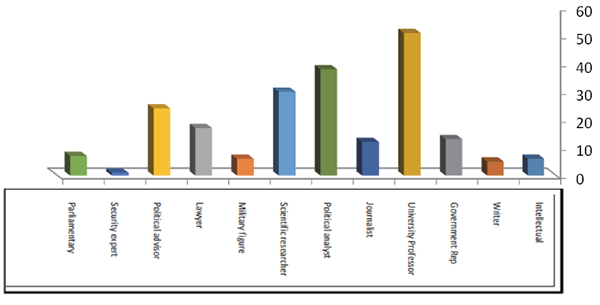
Figure 5: Career titles of hosted guests
Table 5 data indicates that most of the interviews conducted in the talk shows covering the Khashoggi case on Al Jazeera focused on a series of career titles of the hosted guests. Most notably are the following:
• University Professor, by 24.3%.
• Political analyst, by 18.1%.
• Scientific researcher, by 14.3%.
• Political advisor, by 11.4%
• Lawyer, by 8.1%.
• Government representative, by 6.2%
• Journalist, by 5.7%
Results of question 5: What methods did the presenter follow in the dialogue?
Table 6: Methods of dialogue with hosted guests in the talk shows
|
Dialogue Methods |
Iteration |
Percentage |
|
Propaganda methods |
30 |
14.4% |
|
Discussion methods |
96 |
45.9% |
|
Analytical methods |
39 |
18.7% |
|
Dialogue Methods |
Iteration |
Percentage |
|
Suggesting opinions and ideas |
2 |
1.0% |
|
Mixed |
33 |
15.8% |
|
Other |
10 |
4.8% |
|
Total |
210 |
100% |
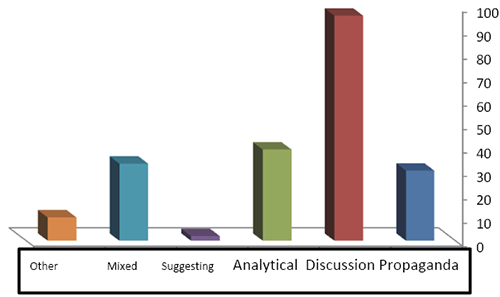
Figure 6: Methods used in dialogue with hosted guests
It is clear from table (6) that the most common method used in the dialogues with the hosted guests in the talk shows related to the Khashoggi case on Al Jazeera were the discussion methods that are based on suggesting ideas and requesting opinions and suggestions from the guest and the public. This amounted to (45.9%) of all the dialogue methods. This is followed by analytical methods (18.7%), mixed methods (15.8%), propaganda methods (14.4%), other methods not mentioned in the categories of analysis (4.8%), and in the last place came the method of suggesting opinions and ideas, by (1%) only.
Results of question 6: What is the nature of the supporting material included in the dialogue?
Table 7: The nature of supporting material in the talk shows on Al-Jazeera
|
Job titles |
Iteration |
Percentage |
|
News |
00 |
00 |
|
Video |
19 |
9.1% |
|
Animation |
2 |
1.0% |
|
Still image |
2 |
1.0% |
|
Video-Taped News Report |
00 |
00 |
|
Field report |
00 |
00 |
|
Recorded report |
00 |
00 |
|
Interview |
115 |
55.0% |
|
Witnesses |
00 |
00 |
|
Maps |
00 |
00 |
|
Infographic |
00 |
00 |
|
Other |
00 |
00 |
|
Mixed |
72 |
34.4% |
|
Sound effects |
00 |
00 |
|
Promo |
00 |
00 |
|
Total |
210 |
100% |
Table 7 data indicate that most of the dialogues conducted in the talk shows in the coverage of the Khashoggi case on Al Jazeera focused on a range of supporting materials, most notably the interview by 55.0%, mixed materials by 34.4%, and video by 9.1%.
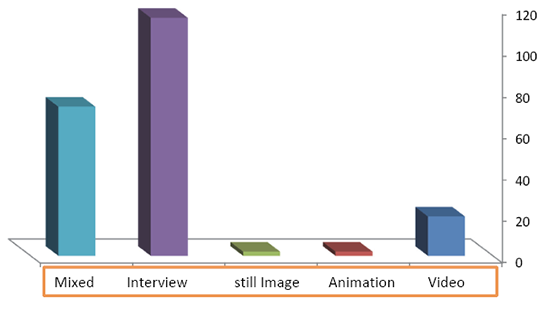
Figure 7: The nature of supporting material in talk shows
Results of question 7: Did the broadcaster grant his guests enough time to talk? And was there balance in the time granted?
Table 8: Balance of Time in Talk Shows
|
Balance in time |
Iteration |
Percentage |
|
Granted guest enough time |
75 |
35.9% |
|
Justice among guests |
63 |
30.1% |
|
Bias to a particular guest |
37 |
17.7% |
|
Other |
35 |
16.3% |
|
Total |
210 |
100% |
It is clear from table (8) that the issue of time balance in most dialogues depended on whether the host gave enough time to the guests, which was at 35.9%, followed by the issue of the presenter’s justice towards the guests at (30.1%).
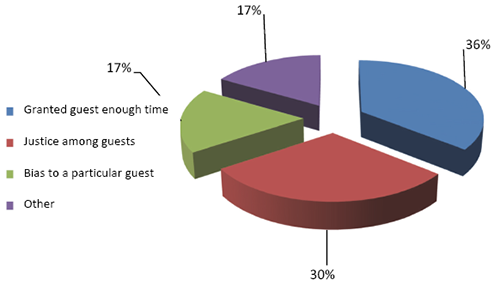
Figure 8: Balance of time in talk shows
Results of question 8: How objective was the presenter in managing the dialogue?
Table (9): The objectivity of the presenter in the talk shows
|
Presenter’s objectivity |
Iteration |
Percentage |
|
Interferes in dialogue. |
119 |
57.5% |
|
Doesn‘t interfere in dialogue. |
38 |
18.4% |
|
Neutral |
20 |
9.7% |
|
Other |
32 |
15.5% |
|
Total |
210 |
100% |
It is clear from table (9) that 57.5% of the presenters in the sample talk shows covering the Khashoggi case on Al-Jazeera channel do interfere in the dialogue, 18.4% do not interfere in the dialogue, and 9.7% were neutral.
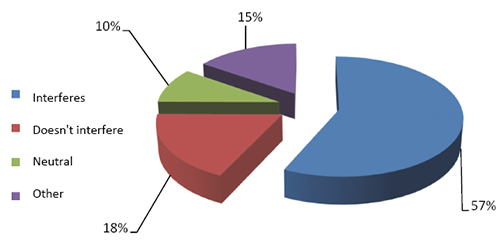
Figure (9): Presenter’s objectivity in the talk shows
Results of question 9: What is the direction of the dialogue in the talk shows covering the Khashoggi case on Al-Jazeera?
Table (10): The direction of dialogue in the talk shows on Al-Jazeera
|
Dialogue Direction |
Iteration |
Percentage |
|
Positive |
3 |
1.4% |
|
Negative |
163 |
77.5% |
|
Neutral |
40 |
19.1% |
|
Other |
4 |
1.9% |
|
Total |
210 |
100% |
Table (10) data indicate that the dialogue direction in the talk shows covering the Khashoggi case on Al Jazeera were negative by (77.5%), while positive directions were only (1.4%), neutral directions accounted for (19.1%), and other directions that are not mentioned in the analysis categories accounted for only (1.9%).
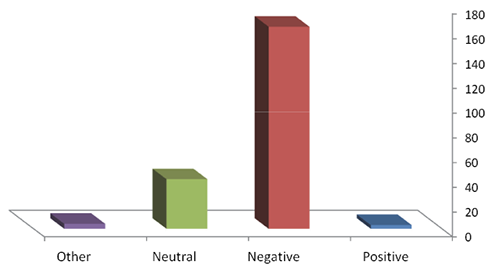
Figure (10): The direction of dialogue in the talk shows on Al Jazeera
Results of question 10: What temptations were employed during the dialogue?
Table (11): Temptations in the talk shows on Al Jazeera
|
Temptations |
Iteration |
Percentage |
|
Religious |
2 |
1.0% |
|
Emotional |
9 |
4.3% |
|
Scientific knowledge |
10 |
4.8% |
|
Legal |
1 |
0.5% |
|
Humane |
0 |
00 |
|
Pragmatic |
9 |
4.3% |
|
Political |
45 |
21.5% |
|
Mixed |
78 |
37.3% |
|
Unclear. |
56 |
26.8% |
|
Other |
00 |
00 |
|
Total |
210 |
100% |
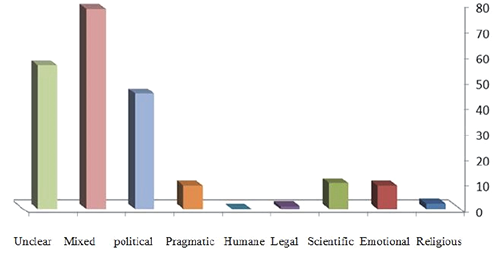
Figure (11): Dialogue Temptations in talk shows on Al-Jazeera
It is noted from table (11) that the temptations employed in the talk shows covering the Khashoggi case on Al Jazeera focused on mixed temptations ranking first at (37.3%), unclear temptations in the second place by (26.8%), political temptations in the third place at (21.5%), while the percentage of other temptations was very low.
Results of question 11: Was there hate speech in these episodes? What hate speech elements were achieved?
Table (12): Hate speech in talk shows on Al-Jazeera
|
Hate speech |
Iteration |
Percentage |
|
Hate speech existence |
146 |
69.4% |
|
Emotional mobilization |
85 |
40.7% |
|
Incitement |
17 |
8.1% |
|
Insults |
1 |
0.5% |
|
Libel and slander |
2 |
1.0% |
|
Stigma |
3 |
1.4% |
|
Profiling |
5 |
2.4% |
|
Accusation |
33 |
15.8% |
|
None |
64 |
30.6% |
|
Total |
210 |
100% |
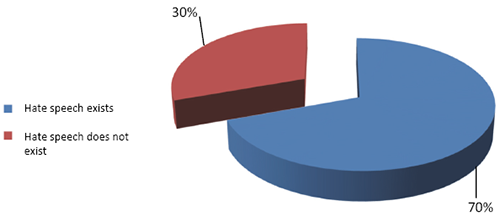
Figure (12): Hate speech in Al-Jazeera talk shows
It is noted from table (12) that there is hate speech in the talk shows that dealt with the Khashoggi case on Al-Jazeera at (69.4%). On top came emotional mobilization at (40.7%), accusation at (15.8%), and incitement at (8.1%).
8. Discussion & conclusions
The above data show that the volume of coverage of Jamal Khashoggi’s case based on the study sample is as high as (93%). “Beyond the News” talk show was the highest in this coverage. Thus, the first hypothesis proposed in this paper, the intense media coverage of Khashoggi’s case, is proven to be true.
In his interview, Al-Humaidi commented on this part, saying that each coverage has its elements and circumstances that limit the degree of intensification, and that Khashoggi’s coverage has achieved its elements. These include: Khashoggi is human, Al-Jazeera is concerned with human beings, and he is a journalist and his topic is related to media freedoms, as well as the fact that Khashoggi’s case is a mystery story and exciting to viewers. It is also a huge survey. For example, no head of an important state in the world has not made a declaration on it. These are tempting and attractive elements to any journalistic work. Furthermore, Khashoggi’s case did not coincide with any other big issues, such as war, explosions in a capital or similar stories. (Al-Humaidi, 2019).
The results also show that most of the dialogues that took place within the sample were opinion dialogues which ranked first. This is a type of dialogue that aims at exploring the interlocutor’s opinion on a certain topic. Last came the information dialogue that aims at gathering information on a certain topic.
It also appears that most of the dialogues that took place took the form of via-satellite multi-guest dialogues. The most prominent job title of the guests hosted in these shows was university professor, followed by political analyst, then scholar, and finally, political consultant.
It was also found that the most common methods utilized in the dialogues with the hosted guests were the discussion methods based on proposing ideas and requesting opinions and suggestions from the guest and the public. Most of the dialogues employed a range of supporting materials, most notably the interview, mixed materials, and video.
In terms of time balance, guests were granted enough time by 35.9%, while the ratio of justice among guests was 30.1%. It was established through previous monitoring and analysis that most of the presenters on the talk shows within the sample intervened during the guest’s participation. The percentage of this intervention was 57.5%, which shows the negative direction in terms of professional performance in relation to the sample in question at 77.5%. This is a high percentage that supports the second hypothesis in this paper, i.e., that there were professional violations in Al-Jazeera coverage of the Khashoggi case. This is confirmed by the percentages of the existence of hate speech within the sample. Such speech appeared as high as 69.4%, emotional mobilization in second place at 40.7%, followed by accusation at 15.8%, and incitement at 8.1%.
It appears from the discussion above that the hypotheses on which this paper is based are proven to be valid, as demonstrated by the media theories used in the research. The Frame Analysis Theory was thus validated by Al-Jazeera’s utilization of linguistic and descriptive influences. Case-limited frame is also evident in this research through the processing of a particular issue and focusing on some of its aspects to finally produce it in a certain way that suits the news medium. The human-concerns framework, which places events in a human and emotional context, has also been chosen. And the media material has been formulated through some dramatic and emotional formulations, apart from the fact that the presenter chose a particular frame for the receiver to see the event through. The presenter is also subject to his cognitive patterns and professional pressures. “Qatar’s policy has nothing to do with Al-Jazeera. I sometimes blame the employees for the elaborate details about Qatar, because we are not a Qatari TV. On the other side, I am influenced by my presence in Qatar because I am on the land of Qatar, but within limits that do not affect the DNA of Al-Jazeera or the professional boundaries. We always tell the journalists to avoid two types of darkness: the darkness of the grave and the darkness of the prison.“(Al-Humaidi, 2019)
Framing applied to other issues in Al-Jazeera sample, including the mechanisms used, the location and space that was allocated to the story, the use of supporting materials, subjectification, emotional temptations through a dramatic nature, selectivity, partiality, demonization, introductions, closures, and headlines in the media article.
From the results that showed the intensity of coverage of the issue of Khashoggi’s murder, the frequency of talk shows and grooming, it can be concluded that:
• Al-Jazeera sought to direct public opinion against Saudi Arabia in general and Mohammed bin Salman in particular.
• The Al-Jazeera channel covered the issue of Khashoggi’s murder through its newsletters and through many talk shows, as most of the dialogues that took place on talk shows covering the Khashoggi case on Al-Jazeera were opinion dialogue programs.
• Most of the dialogues that took place on talk shows covering the Khashoggi case on Al-Jazeera were a form of (dialogue of more than one character), focused on a set of job titles for the hosted characters, and the most prominent of these job titles were (university professor - political analyst - scientific researcher - consultant Politician - lawyer).
• The most used methods of dialogue with the characters hosted in the dialogue programs related to the Khashoggi issue on Al-Jazeera were the discussion methods based on brainstorming and seeking opinions and suggestions from the guest and the public, and were based on a set of supporting materials, most notably the interview, mixed materials and video.
• Although balance time was achieved in most of the dialogues, most of the broadcasters on the Al-Jazeera talk shows were not neutral as they interfered with the dialogue.
• Most of the dialogue trends in the talk shows that covered the Khashoggi case on Al-Jazeera were negative, and it was noted that there was hate speech such as accusation and incitement.
References
Azzam, Sayah. (2017). The Study of the Current Gulf Crisis - Roots and Causes, Journal of Political Thought, (64), 60-61.
Al Humaidi, Asif, interview at Al Jazeera headquarters, Doha, Qatar, October 18, 2019.
Al-Halahleh, Ali. (2012). Social Values in Talk Shows in Jordanian Television from the Perspective of Jordanian University Students, Unpublished Master Thesis, Middle East University, Amman, Jordan.
Al-khazendar, Ali, Sami, Yahia. (2013). Professionalism and Objectivity of Al- Jazeera Satellite Channel, American International Journal of Contemporary Research, (3) 9, 68- 70.
Al-Mansour, Ahmed Issa. (2015). Arab newspapers cover Trump’s decision, “Jerusalem is the capital of Israel,” Journal of Gaza University, (12) 22, 68-76.
Al-Mutairi, Ghazi Ali. (2016). Talk shows in Arab satellite channels and their relationship to the formation of political trends among Kuwaiti university youth, Ain Shams University Journal, (44) 3, 533-564.
Al-Ramadani, Badr. (2018). “The Gulf Crisis: Context and Attitudes”, Al-Manara Magazine for Legal and Administrative Studies, Special Issue, 92.
Alskaji, Omar Ahmed. (2018). Analyzing the content of scientific programs in children’s Arabic satellite channels and investigating their effects as an informal context in learning science, PhD thesis, University of Jordan, Amman, Jordan.
Al-Yamahi, Ali Khamis. (2012). The role of the talk shows in Abu Dhabi TV to raise the awareness of university students on regional political issues, unpublished Master Thesis, Faculty of Media, Yarmouk University, Irbid, Jordan.
Ananza, Azzam Ali. (2017). The dependence of the Jordanian elites on the talk shows in Al-Jazeera as a source of political information, Al-Hawliyya Journal, (38)489, 9-32.
Azran, Assaf, Salem, Wahabe, Halabi, Tal- Samuel, Inbal, Annie, Loreen, Nadine. (2016). Is there a Qatari-Al-Jazeera nexus? Coverage of the 2022 FIFA World Cup controversy by Al-Jazeera versus Sky News, CNNI and ITV, Research Gate,.
Entman, R. (1993). Framing: Toward clarification of a fractured paradigm. Journal of Communication, 43 (4), p. 52.
Entman, R., Matthes, J., & Pellicano, L. (2009). Nature, sources, and effects of news framing. Nimmo & K. Sanders Handbook of Political Communication, London: Sage Publication. California: Sage Publication.
Hassouna, Nisreen. (2015). “Theories of Media and Communication”, Alukah Network (www.alukah.net).
Janabi, Alaa Murad. (2016). Al Jazeera and Russia Today Coverage of the Russian Military Campaign in Syria: A Comparative Study, Unpublished Master Thesis, Faculty of Information, Middle East University, Amman, Jordan.
Kanaan, Ali Abdel Fattah. (2014). Opinion and other opinion in the media, Dar Al-Ayyam for Publishing, Amman, Jordan.
Moula, Ali. (2017). Al Jazeera” and the Gulf Crisis: Background and History, Siyasat Arabiya,(27), 67-70.
Neuendorf, Kimberly A. (2002). The Content Analysis Guidebook, London, Sage Publications
Robin L. Nabi. (2003). Exploring the Framing Effects of Emotion: Do Discrete Emotions Differentially Influence Information Accessibility, Information Seeking, And Policy Preference, Communication Research, (30)2, 222-231.
Seib, Powers, Gilboa, Philip, Shawn, Eytan. (2007). The Public Diplomacy of Al Jazeera, New Media and The New Middle East, Palgrave Macmillan.
Shanto, Iyengar and Adam, Simon. (1993) News Coverage of the Gulf Crisis and Public opinion: A Study of Agenda- Setting, priming, and framing, Communication Research, (20) 3, 367-376.
Suleiman, Sana Muhammad. (2015) Research Methods in Education and Psychology and his basic skills, 4th edition, World of Books, Cairo, Egypt.
Sultan, Anaam Muhammad. (2004). Media and Publicity and its Impact on Public Opinion, Dar Al-Yazouri for Publishing and Distribution, Amman, Jordan.
De vreese, Claes. (2005). News Framing: Theory and Typology, Information Design Journal, (7), 53- 54.
Ziolkowski, Janusz. (2001). Democracy, Public Opinion And The Media, Pontifical Academy Of Social Sciences,(12). 173-204.